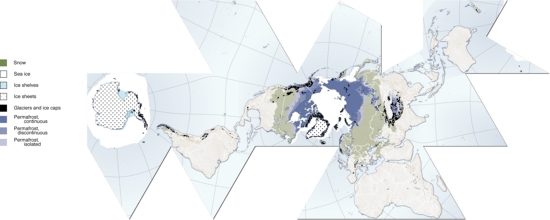1.1 The cryosphere and its polar regions
The cryosphere (derived from the Greek word for cold ‘kryos’) is the scientific term for the parts of the Earth’s surface that are frozen. The cryosphere includes snow, permafrost, ice on rivers and lakes, glaciers, ice caps and sea ice (see Figure 1).

Figure1. Overview of the cryosphere and its larger component (UNEP/GRID-Arendal 2007a).
It includes the great ice sheets of Antarctica and Greenland; the sea ice of the Arctic and Antarctic; frozen stretches of Canada, Siberia, and other lands within the Arctic Circle; and also mountain glaciers.
Two major cryosphere elements are:
- Polar ice – The great polar regions of the Arctic and Antarctica. Although very different in many respects, both of these regions are dominated by cold conditions and the presence of ice, snow, and water. A key difference is that the polar Arctic is a frozen ocean surrounded by continental landmasses and open oceans, whereas Antarctica is a frozen continent surrounded by oceans. (IPCC 2001).
- Alpine glacier – Glaciers confined by surrounding mountain terrain. They are also called mountain glaciers (NSIDC, 2009) and include many outside of the polar regions (for example the extensive Himalayan and Andean glacier systems).
Why the cryosphere is so important to our climate
The cryosphere is an integral part of our global climate system. For example, the reflective (albedo) properties of white crystals of snow and ice, along with frozen ground or permafrost are very effective at bouncing most of the sun’s energy that strikes them back into space. This greatly influences how much of the sun’s energy is retained to heat our planet (IPCC 2007). The moisture content of the atmosphere along with cloud, rain and storm patterns are all greatly influenced by the cryosphere as are river, lake and other water dynamics. The freezing over of sea ice and the melting of ice sheets and glaciers is a major influence the global circulation of oceans by affecting the ratio of fresh water to salt (NCAR, 2009).
Other reasons to appreciate the cryosphere
In addition to providing a wide and diverse range of biodiversity supporting ecosystems and socio-economic benefits, the cryosphere locks up huge amounts of water that if returned to its liquid state would raise global average sea levels by at least 65 metres or 213 feet (UNEP 2007). This is a key consideration as, working in concert with other climate change impacts, even a metre or so of sea level rise is sufficient to threaten many of the world’s coastal habitats and human settlements (World Bank 2010; Hallegatte et al 2013)
Find out more:
- National Snow & Ice Data Center. State of the cryosphere
- Richard Z. Poore, Richard S. Williams, Jr., and Christopher Tracey Sea Level and Climate. Fact Sheet fs002–00 January 2000, rev. September 2011 Sea Level and Climate. US Geological Survey
- EarthLabs: Future of the Cryosphere Part B: Sea Level Rise
- UNEP (2009) Climate Change Science Compendium 2009
- World Bank (2010) Turn down the Heat. Why a 4 degree centigrade warmer world must be avoided.